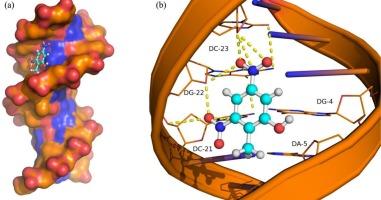The elucidation of major groove binding of Dinitro-ortho-cresol herbicide to DNA: a multi-approach of voltammetric, spectroscopic, and computational modeling methods
IF 4.2
Q2 CHEMISTRY, MULTIDISCIPLINARY
引用次数: 0
Abstract
This study examined the binding of Dinitro-ortho-cresol (DNOC) herbicide with Calf thymus deoxyribonucleic acid (Ct-DNA) using spectroscopic, voltammetric, docking, and molecular dynamics methods. Cyclic voltammetry results showed two irreversible cathodic peaks (peaks I and II) at the potentials of −0.48 and −0.76 V, which are related to the reduction of -NO2 groups of DNOC to -NHOH groups. The cyclic voltammetry results measured the binding constant and binding site size of DNOC to DNA at 3.58 × 103 and 0.85, respectively. Also, the diffusion constants for DNOC (Df) and DNOC-DNA complex (Db) were 3.4 × 10−3 and 6.5 × 10−5, respectively. A great decrease in the intensity of vibrations related to guanine and cytosine functional groups was observed compared to adenine and thymine. These changes show that DNOC has a greater tendency to interact with guanine and cytosine rather than adenine and thymine. All voltammetric and fluorescence spectroscopy data shows that the interaction between the DNOC and DNA is more thorough in the major groove. These experimental data are in agreement with theoretical data.

二硝基邻甲酚除草剂与DNA的主要凹槽结合:伏安法、光谱法和计算建模方法的多种方法
采用光谱、伏安、对接和分子动力学等方法研究了二硝基邻甲酚(DNOC)除草剂与小牛胸腺脱氧核糖核酸(Ct-DNA)的结合。循环伏安法结果显示,在−0.48和−0.76 V电位下,DNOC的-NO2基团还原为-NHOH基团,出现了两个不可逆的阴极峰(峰I和峰II)。循环伏安法测得DNOC与DNA的结合常数为3.58 × 103,结合位点大小为0.85。DNOC的扩散常数Df和DNOC- dna复合物Db分别为3.4 × 10−3和6.5 × 10−5。与腺嘌呤和胸腺嘧啶相比,观察到与鸟嘌呤和胞嘧啶官能团相关的振动强度大大降低。这些变化表明DNOC更倾向于与鸟嘌呤和胞嘧啶而不是腺嘌呤和胸腺嘧啶相互作用。伏安光谱和荧光光谱数据表明,DNOC与DNA的相互作用在主槽中更为彻底。这些实验数据与理论数据一致。
本文章由计算机程序翻译,如有差异,请以英文原文为准。
求助全文
约1分钟内获得全文
求助全文

 求助内容:
求助内容: 应助结果提醒方式:
应助结果提醒方式:


